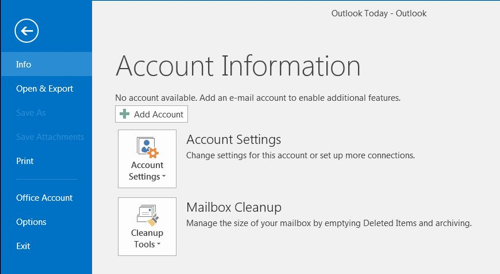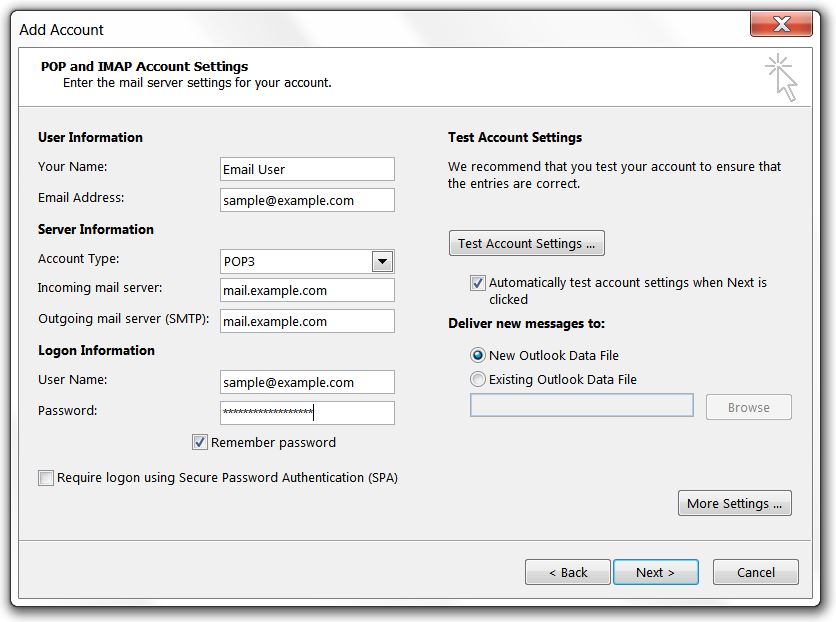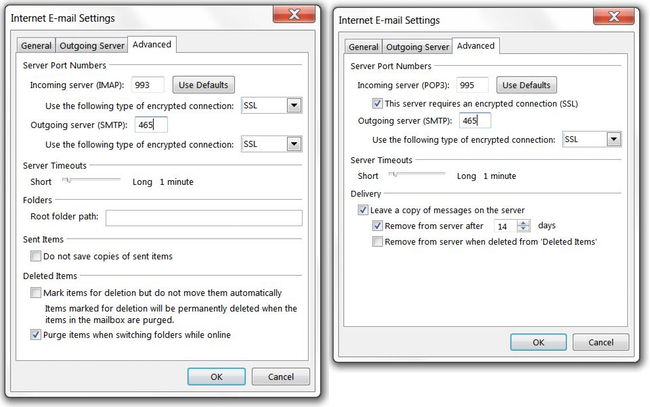Step #1: Add or Edit the Email Account
1. To set up a new email account, click the "File Tab" and then click "Add Account".

2. If you are modifying the settings on an existing account (already configured in Outlook),
click on Account Settings and then click on Change settings for this account or set
up more connections
Step #2: Manual Setup for a New Email Account
A. Select the option for Manual setup or additional server types.
B. Then click Next.
Step #3: Select Email Account Type
A. Select the POP or IMAP.
B. Then click Next.
Step #4: Modifying an Existing Account
A. If you’re editing an email account (that already has been configured in Outlook),
click on the account name and then click on the Change button.
Settings
B. To avoid data loss, please use caution when changing an email account’s connection type or delete an email account. Removing an email account from a mail client will also remove all messages associated with it on the device and specifically in the case of POP accounts that are not configured to retain mail on the server, there may be no way to recover those messages. If you require assistance please contact support@saservers.co.za.
Step #5: Configure General Settings

Your Name is your name as you want it to appear in emails that you send
Email Address should be the full email address
Account Type will be POP3 or IMAP, depending on your preference. For its ability to keep email in sync
across multiple devices (desktop, laptop, phones and tablets), IMAP generally is recommended.
Incoming mail server
• When using standard (non-SSL) settings, use mail.yourdomainname.com
• When using secure (SSL) settings, use the server’s hostname (host.yourdomainname.com)
Outgoing mail server (SMTP)
• When using standard (non-SSL) settings, use mail.yourdomainname.com
• When using secure (SSL) settings, use the server’s hostname (host.yourdomainname.com)
User Name is your full email address, not just the prefix before the @ symbol.
Password is the email account password.
Require logon using Secure Password Authentication (SPA) must not be checked.
SPA is not the same as SMTP authentication, which is used on cPanel servers.
Step #6: Configure Outgoing Server Settings
A. Click the More Settings button, and select the Outgoing Server tab.
My outgoing server (SMTP) requires authentication should be checked
Use same settings as my incoming mail server should be enabled
Log on to incoming mail server before sending mail (POP3 only) should not be enabled.
That setting applies only to servers configured to allow POP Before SMTP authentication,
in which a successful login to retrieve mail allows a user from the same IP address to also
send mail for a period of time. It is not compatible with servers requiring SMTP authentication.
Now select the Advanced tab at the top of the More Settings window.

Step #7: Configure Ports and Encryption
1. Fill in the Advanced settings using the images and instructions below.
2. Once complete, click OK to return to the previous window.

Advanced Internet E-mail Settings screens for email accounts using IMAP (left) and POP3 (right) connection methods over a standard (non-SSL) network connection.
Standard (Non-SSL) IMAP Settings |
Standard (Non-SSL) POP3 Settings |
|
|

Advanced Internet E-mail Settings screens for email accounts using IMAP (left) and POP3 (right) connection methods over a secure (SSL) network connection.
Secure (SSL) IMAP Settings |
Secure (SSL) POP3 Settings |
|
|

Click the Next button to make a connection to the server and test the configuration.
A. If you’re using SSL settings and your server has a self-signed (free) SSL certificate installed on the mail server, you may get a pop up warning.
B. If so, you will need to click the Yes button to accept the certificate and proceed. Alternatively, you may select View Certificate and then click Install Certificate on the next screen to install the certificate locally and prevent the notice on subsequent connections.
C. Once you click Yes, Outlook will test the connection settings.
D. When you see the success message, you’re ready to start using your email address with Outlook 2016.
Note: A self-signed certificate uses the same level of encryption as a verified certificate, except that it is you who are verifying your server’s identity, rather than a third party. However, if you would prefer to use a third-party verified SSL certificate to cover core services (cPanel/WHM, POP3, IMAP, SMTP and FTP) on your server, you can find instructions for ordering and installing an SSL certificate at Install an SSL Certificate on a Domain using cPanel, and you’ll find a guide to installing your certificate on email and other core server services at Installing Service SSLs in cPanel. Should you find that you need any assistance, please feel free to contact a Heroic Support® technician who can assist with obtaining and installing an SSL from the vendor of your choice.
Bonus for IMAP Users: Choose Which Folders to Display in Outlook

You can manage your folder subscriptions by clicking on the folder name in the All list and using the Subscribe or Unsubscribe buttons.
Once you’ve finished making changes, click the Apply button and then select OK if needed. It will take a few moments for the folder list to update in your Mail pane.
Note: When subscribing to filtered mail folders such as Spam or Junk, all the mail coming into those folders on the server also will be downloaded and synced to your selected local mail client as well. If you are using a metered Internet connection or have limited bandwidth, please be aware that the transfer of email is not included in your data usage. If you typically receive a large volume of such filtered mail, subscribing to spam and junk folders is not recommended. Please feel free to contact support@saservers.co.za if you need further assistance.


